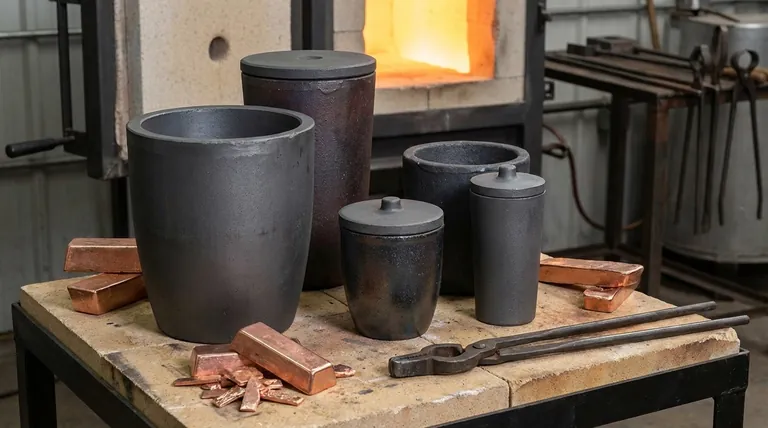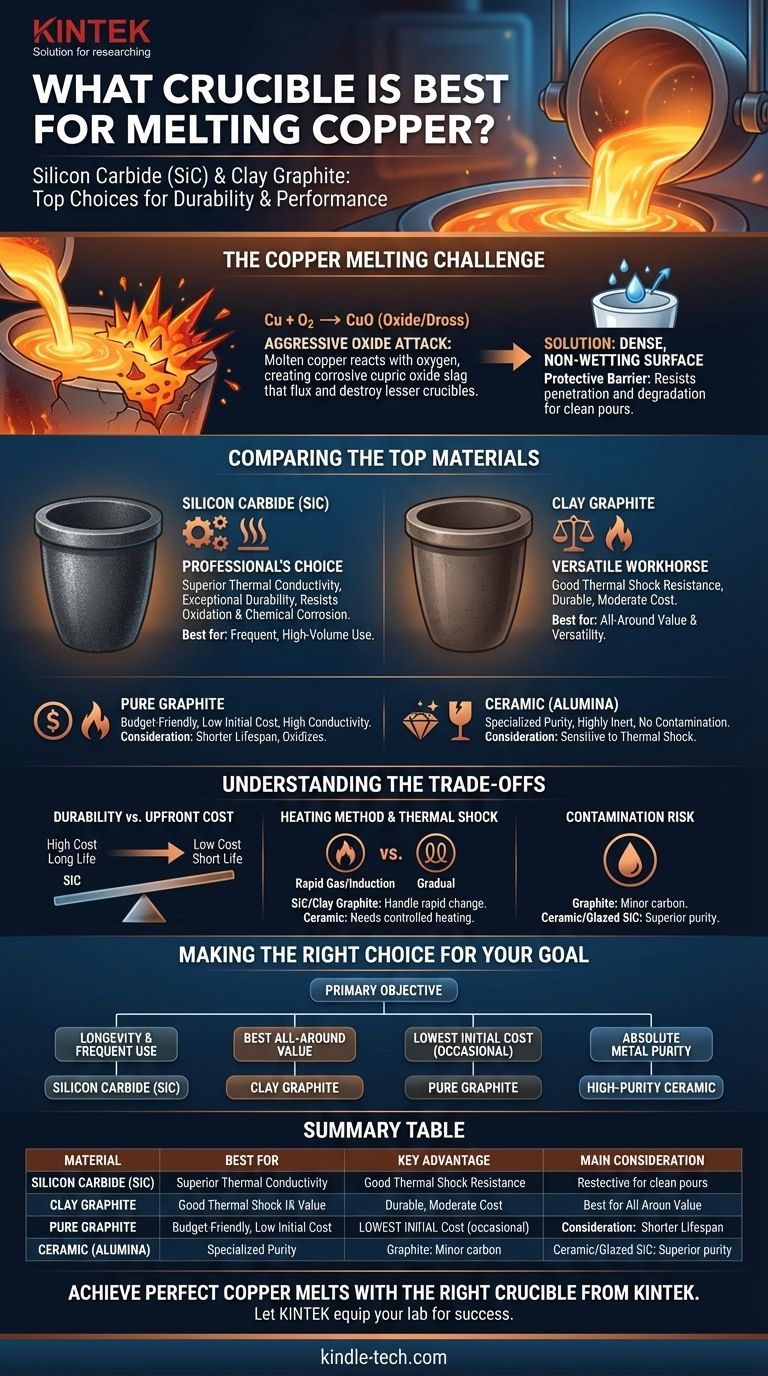For melting copper, your best options are silicon carbide (SiC) for professional-grade durability and performance, or clay graphite for an excellent balance of cost and reliability. While other materials exist, these two consistently provide the best results for most applications by resisting the high heat and chemical reactivity of molten copper.
The core challenge of melting copper isn't just the temperature; it's managing the aggressive nature of copper oxide that forms during the process. The best crucible is one that not only withstands the heat but also actively resists being degraded by this corrosive chemical reaction, ensuring a clean pour and a long service life.

Why Copper Demands a Specific Crucible
Melting copper presents a unique challenge compared to less reactive metals. Understanding this is key to selecting the right tool for the job.
The Problem of Oxidation
When heated, copper readily reacts with oxygen in the air to form cupric oxide. This oxide layer, known as slag or dross, is chemically aggressive.
It can actively eat away at, or "flux," the wall of a lesser-quality crucible. This process both contaminates your copper melt and rapidly destroys your crucible.
The Need for a Dense, Non-Wetting Surface
To combat this, a crucible for copper must have two key properties, as noted for precious metals. It needs a dense material structure and a non-wetting surface, often achieved with a protective glaze.
This barrier prevents the molten copper and, more importantly, the corrosive oxides from penetrating and degrading the crucible material.
Comparing the Top Crucible Materials for Copper
Each common crucible material offers a different set of advantages. Your choice depends on your budget, frequency of use, and desired purity.
Silicon Carbide (SiC): The Professional's Choice
Silicon carbide is widely considered the premium material for melting copper. It is a man-made ceramic composite known for extreme durability.
Its key advantages are superior thermal conductivity (it heats up quickly and evenly) and exceptional resistance to oxidation and chemical corrosion. A SiC crucible will far outlast its counterparts, making it the most cost-effective choice for frequent use.
Clay Graphite: The Versatile Workhorse
Clay graphite crucibles are a composite of graphite, silicon carbide, and clay. They are the most common type found in both hobbyist and professional foundries.
They offer a fantastic balance of thermal shock resistance, good durability, and moderate cost. They are more durable than pure graphite but more affordable than pure silicon carbide, representing a perfect middle ground.
Pure Graphite: The Budget-Friendly Option
Crucibles made of pure graphite have excellent thermal conductivity and are very resistant to thermal shock. They are also typically the least expensive option.
However, graphite's main weakness is that it oxidizes (burns away) in the presence of air at high temperatures. This means a graphite crucible is a consumable item with a limited lifespan, and it can potentially introduce carbon into your copper melt.
Ceramic Crucibles: For Specialized Purity
High-purity ceramic crucibles, such as those made from alumina or zirconia, are used in laboratory or industrial settings where metal purity is the absolute priority.
They are highly inert and will not contaminate the melt. However, they are often more expensive and far more sensitive to thermal shock (cracking from rapid heating or cooling) than SiC or graphite-based crucibles.
Understanding the Trade-offs
Choosing a crucible isn't just about picking the "best" one; it's about understanding the compromises between cost, performance, and longevity.
Durability vs. Upfront Cost
A silicon carbide crucible may cost significantly more than a clay graphite one initially. However, it can last many times longer under heavy use, making its cost-per-melt much lower over its lifetime. A pure graphite crucible is cheapest but may only last for a handful of melts.
Heating Method and Thermal Shock
The way you heat your crucible matters. Gas-fired and induction furnaces heat very quickly. Silicon carbide and clay graphite are engineered to handle this rapid temperature change without cracking.
High-purity ceramics are much less tolerant of this "thermal shock" and require a more controlled, gradual heating cycle to prevent failure.
Contamination Risk
For most casting projects, the minor carbon introduction from a graphite crucible is irrelevant. However, for high-purity electrical applications or specific alloys, this could be an issue. In those cases, a ceramic or a well-glazed SiC crucible is the superior choice.
Making the Right Choice for Your Goal
Select your crucible based on your primary objective to ensure the best use of your resources.
- If your primary focus is longevity and frequent professional use: Choose a Silicon Carbide (SiC) crucible for its unparalleled durability and long-term value.
- If your primary focus is the best all-around value and versatility: Choose a Clay Graphite crucible for its excellent balance of performance, durability, and cost.
- If your primary focus is the lowest initial cost for occasional melts: Choose a Pure Graphite crucible, but understand that it is a consumable with a limited lifespan.
- If your primary focus is absolute metal purity for scientific or specialty alloys: Choose a high-purity Ceramic crucible like alumina, and be prepared for careful heating protocols.
Ultimately, selecting the correct crucible is a foundational step toward achieving a clean, successful, and repeatable copper casting process.
Summary Table:
| Crucible Material | Best For | Key Advantage | Main Consideration |
|---|---|---|---|
| Silicon Carbide (SiC) | Frequent, professional use | Superior durability & longevity | Higher upfront cost |
| Clay Graphite | Best all-around value | Excellent balance of cost & performance | Most versatile option |
| Pure Graphite | Low-cost, occasional melts | Lowest initial price | Shorter lifespan; oxidizes |
| Ceramic (e.g., Alumina) | Absolute metal purity | Highly inert, no contamination | Sensitive to thermal shock |
Achieve perfect copper melts with the right crucible from KINTEK.
Whether you're a professional metalworker prioritizing durability or a hobbyist seeking the best value, the correct crucible is essential for a clean pour and long-term success. KINTEK specializes in high-performance lab equipment and consumables, including a full range of crucibles designed for demanding applications like melting copper.
Our experts can help you select the ideal crucible—be it long-lasting silicon carbide, versatile clay graphite, or cost-effective pure graphite—to match your specific needs, budget, and heating method.
Let KINTEK equip your lab for success. Contact our experts today for a personalized consultation and ensure your next copper melt is your best one yet.
Visual Guide

Related Products
- High Purity Pure Graphite Crucible for Electron Beam Evaporation
- High Purity Pure Graphite Crucible for Evaporation
- Electron Beam Evaporation Coating Oxygen-Free Copper Crucible and Evaporation Boat
- Engineering Advanced Fine Ceramics Alumina Al2O3 Crucible With Lid Cylindrical Laboratory Crucible
- Custom Machined and Molded PTFE Teflon Parts Manufacturer with PTFE Crucible and Lid
People Also Ask
- How does a magnetron sputtering work? A Guide to High-Quality Thin Film Deposition
- What are the effects of magnetron sputtering? Achieve High-Quality, Durable Thin Films for Your Lab
- What is direct current DC magnetron sputtering? A Guide to High-Quality Thin Film Deposition
- What is sputtering technology? A Guide to Precision Thin Film Deposition
- What is a magnetron sputtering? A Guide to High-Quality Thin-Film Deposition



















